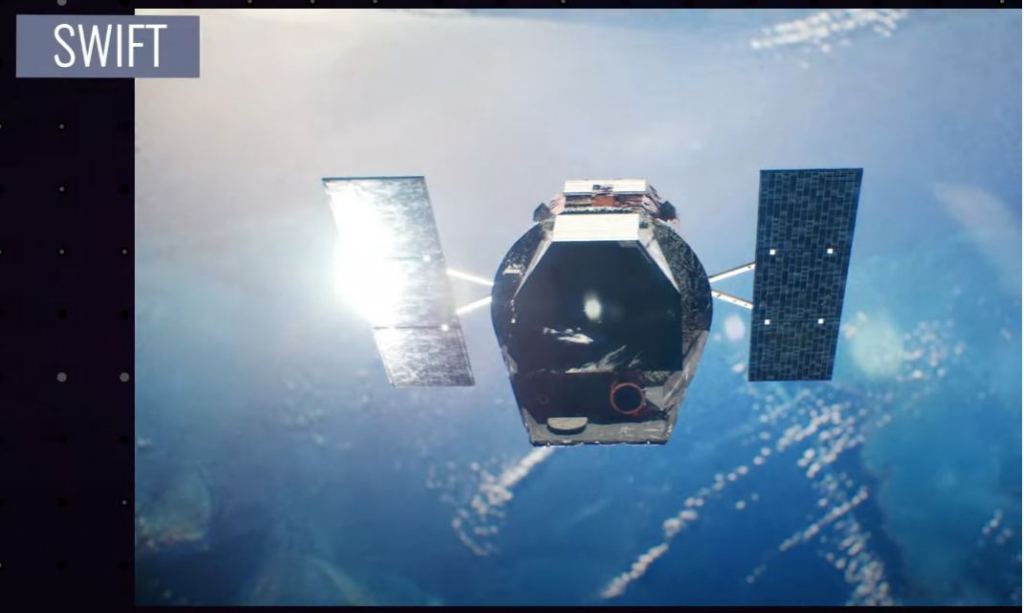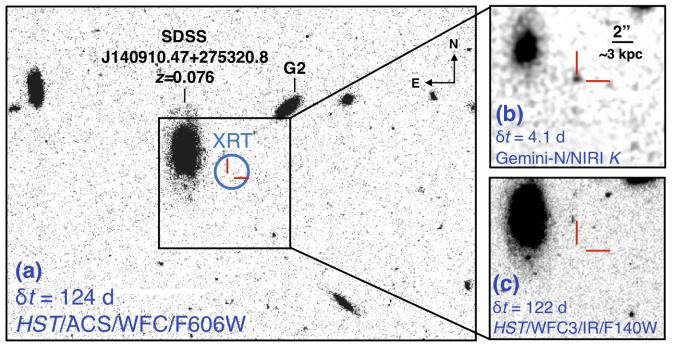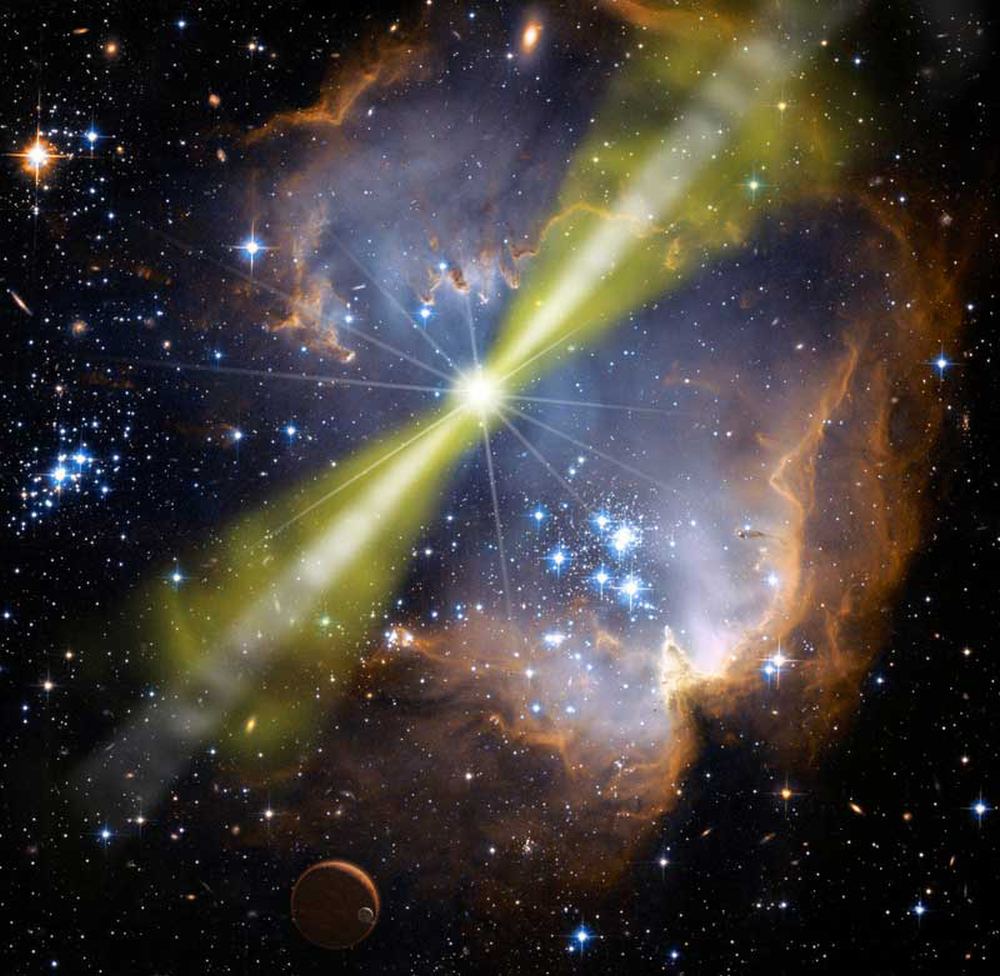Gamma-Ray Bursts (GRBs) are the most energetic recurring events in the Universe. Only the Big Bang was more energetic, and it was a singularity. Astronomers see GRBs in distant Universes, and a lot of research has gone into understanding them and what causes them.
A new paper is upending some of what scientists thought they knew about these extraordinary explosions.
The discovery of GRBs dates back to the Cold War. As nuclear weapons testing proliferated through the 1950s and 60s, the US and the Soviet Union signed the Partial Test Ban Treaty. The treaty banned all nuclear weapons testing except for underground tests. Nuclear detonations release gamma rays and the US built and launched the Vela satellites to monitor the Soviet Union’s adherence to the treaty.
The Vela satellites started detecting bursts of gamma radiation, but scientists soon realized that they weren’t coming from nuclear weapons or even from Earth. Eventually, scientists at the Los Alamos Scientific Laboratory determined the sky positions for 16 GRBs. Researchers published a paper in the Astrophysical Journal in 1973 eliminating the Sun or the Earth as the sources for the GRBs, and the study of GRBs was born.
Now we know a lot more about these events. There are two categories of GRBs: short gamma-ray bursts and long gamma-ray bursts. (There’s a third sub-category called extremely long gamma-ray bursts.)
Scientists tell us that the light curves from GRBs are very complex, and no two are identical. But despite their lack of similarity, astrophysicists have determined their sources. The long ones come from stars that explode as supernovae and then form neutrons stars or black holes. The short ones come from kilonovae. Kilonovae are the result of either a pair of merging neutron stars or a neutron star merging with a black hole.

But a new study is throwing a wrench into our understanding.
The study is “A kilonova following a long-duration gamma-ray burst at 350 Mpc,” and it’s published in the journal Nature. The lead author is Jillian Rastinejad, a Ph.D. student in the Department of Physics & Astronomy at Northwestern University.
“This event looks unlike anything else we have seen before from a long gamma-ray burst.”
Jillian Rastinejad, study lead author, Dept. of Physics and Astronomy, Northwestern University.
Astrophysicists have long believed that long gamma bursts are only caused by supernovae. They also believed that short GRBs come only from kilonovae. But the new study shows us something different. It shows that at least some neutron star mergers can produce long GRBs.
During a GRB, the gamma rays are observed first. But astrophysicists have to wait for the rest of the energy from the precursor event before they know if it was a supernova or a kilonova that caused it.

In December 2021, the team detected a 50-second-long GRB in a galaxy 1.1 billion light-years from Earth. Its name is GRB211211A (2021 is the year, 12 is the month, and 11 is the date of discovery). Two facilities detected it: the Swift Observatory’s Burst Alert Telescope and the Fermi Gamma-ray Space Telescope. A GRB of that length is a long gamma-ray burst, and according to established theory, it should’ve come from a supernova.

But GRBs from a supernova emit an extraordinarily luminous afterglow. The team looked at the region that spawned the GRB with telescopes that can observe all across the electromagnetic spectrum. They watched for the telltale afterglow indicating that a supernova caused the GRB, and there was none. The team was starting to understand that they were seeing something new.
“The weather was worsening in Hawaii, and we were so disappointed because we were starting to uncover hints that this burst was unlike anything we had seen before,” Rastinejad said. “Luckily, Northwestern provides us with remote access to the MMT Observatory in Arizona, and an ideal instrument was being put on that telescope the next day. It was cloudy there, but the telescope operators knew how important this burst was and found a gap between the clouds to take our images. It was stressful but so exciting to get those images in real-time.”
Instead of the tell-tale signs of a supernova, they observed evidence of a kilonova, showing that kilonovae can create long-duration GRBs. This goes against our established understanding.
“This event looks unlike anything else we have seen before from a long gamma-ray burst,” said lead author Jillian Rastinejad. “Its gamma rays resemble those of bursts produced by the collapse of massive stars. Given that all other confirmed neutron star mergers we have observed have been accompanied by bursts lasting less than two seconds, we had every reason to expect this 50-second GRB was created by the collapse of a massive star. This event represents an exciting paradigm shift for gamma-ray burst astronomy.”

The team expected to find evidence of a supernova, but they didn’t. Kilonovae fade quickly, whereas the brightness from supernovae persists for months. In this case, the object that caused the GRB was faint and quickly faded. The consequences of their unexpected findings became clear to them pretty quickly.
“When we followed this long gamma-ray burst, we expected it would lead to evidence of a massive star collapse,” said Northwestern’s Wen-fai Fong, a senior author on the study. “Instead, what we found was very different. When I entered the field 15 years ago, it was set in stone that long gamma-ray bursts come from massive star collapses. This unexpected finding not only represents a major shift in our understanding but also excitingly opens up a new window for discovery.”
Massive stars that explode as supernovae have many times more mass than our Sun, enough to power a longer afterglow. That material falls toward the black hole created by the supernovae but takes its time. The in-falling material is guided away from the black hole in jets, which we see as afterglow.
But neutron stars are small, and astrophysicists thought they simply don’t contain enough material to power a long afterglow, even when two of them merge. “When you put two neutron stars together, there’s not really much mass there,” Fong explained. “A little bit of mass accretes and then powers a very short-duration burst. In the case of massive star collapses, which traditionally power longer gamma-ray bursts, there is a longer feeding time.”
The afterglow that followed the GRB was also unusual in other ways. It contained high-energy gamma rays that started 1.5 hours post-burst and lasted more than 2 hours. Alessio Mei, a doctoral candidate at the Gran Sasso Science Institute in L’Aquila, Italy, led a group that studied the same data. Their paper was also published in Nature.
Mei and his team have an idea why the kilonovae created such a long afterglow. “This is the first time we’ve seen such an excess of high-energy gamma rays in the afterglow of a merger event. Normally that emission decreases over time,” said Mei. “It’s possible these high-energy gamma rays come from collisions between visible light from the kilonova and electrons in particle jets. The jets could be weakening ones from the original explosion or new ones powered by the resulting black hole or magnetar.” (A magnetar is a neutron star with extremely powerful magnetic fields.)
The study of GRBs is fascinating in its own right, and these findings are a new window into GRBs and the events that cause them. But there’s more to this than just the powerful burst. Kilonovae play an important role in creating the Universe’s heavy elements.
It took decades for scientists to understand how all the elements formed. In 2019, a paper in Nature put one of the last pieces of the puzzle into place. It showed that a kilonova explosion in 2017 contained the element strontium. Scientists knew that an atomic process called the r-process was responsible for about half of the atomic nuclei heavier than iron. The r-process is also called the rapid neutron capture process, and it allows an atomic nucleus to capture neutrons faster than it can decay. Scientists thought kilonovae were the site of the r-process, and the 2019 paper was the definitive proof.

Kilonovae are tough to study because they don’t last long. But this discovery of a kilonova with a long gamma-ray burst could help change that by giving scientists a way to spot more kilonovae.
“Kilonovae are powered by the radioactive decay of some of the heaviest elements in the universe,” Rastinejad said. “But kilonovae are very hard to observe and fade very quickly. Now, we know we can also use some long gamma-ray bursts to look for more kilonovae.”
To understand exactly what elements are present in a kilonova, scientists need to use spectroscopy. That’s difficult to do from the ground. There’s a new space telescope that specializes in exquisitely-detailed spectroscopy, but it, unfortunately, was not part of this work.
“With the JWST, we could have obtained a spectrum of the kilonova,” said Rastinejad. “Those spectral lines provide direct evidence that you have detected the heaviest elements.”
Observations by multiple telescopes are at the heart of this discovery. GRB detections by Swift and Fermi were only the beginning. This shows how important coordinated efforts involving many people and facilities are to making progress on complicated events like kilonova explosions. The image of a lone astronomer sitting at her telescope for long hours before finally shouting “Eureka!” is now apocryphal.

“This result underscores the importance of our missions working together and with others to provide multiwavelength follow-up of these kinds of phenomenon,” said Regina Caputo, Swift project scientist at NASA’s Goddard Space Flight Center. “Similar coordinated efforts have hinted that some supernovae might produce short bursts, but this event is the final nail in the coffin for the simple dichotomy we’ve used for years.”
“You never know when you might find something surprising,” Caputo said.
More:
- Press Release: Surprise kilonova upends established understanding of long gamma-ray bursts
- New Research: A kilonova following a long-duration gamma-ray burst at 350 Mpc
- Press Release: NASA Missions Probe Game-Changing Cosmic Explosion
- New Research: Gigaelectronvolt emission from a compact binary merger
- Universe Today: The Expanding Debris Cloud From the Kilonova Tells the Story of What Happens When Neutron Stars Collide


Another paper by Jun Yang (Nanjing University, China) in Nature suggests that this was a collision between a white dwarf and neutron star…